The first, and most crucial step in any tire repair process is to completely remove any foreign material from the damaged area. Photos: Jim Park
The flat tire is arguably motoring’s oldest nemesis. Check out any film or photography from the early Automotive Age, and sooner, rather than later, somebody is going to roll their sleeves up and get to work patching a tire.
Early automotive tires were essentially scaled-up versions of bicycle tires. But they evolved quickly to meet the more rigorous demands put on them by early cars and trucks. Improvements to roads and highways made a big difference, too. So today, full-on tire failures are relatively rare compared to those early years behind the wheel.
But flat tires remain a serious threat for fleets today. And, of course, when flats do occur, they rarely happen in front of your local tire dealer’s store. And fixing a truck tire is a complicated, safety-focused affair. Unlike an enterprising passenger car driver, pulling out a set of tire plugs and setting to work just isn’t going to get the job done.
And, of course, tires aren’t cheap. Smart fleet managers understand that wringing every possible mile from a truck tire saves money. Which means that getting tires fixed properly after failures do occur is vital for both vehicle productivity and fleet profitability.
As with so many things in fleet operations, your drivers are your first line of defense when it comes to tire repairs. And this defense should begin every day with a thorough pre-trip inspection with a focus on good tire health.
The quickest and surest way to determine if there’s a slow leak in a tire is by checking tire pressure with an accurate, properly calibrated tire gauge. Unfortunately, many drivers still believe that whacking a tire with an ax handle is the only pressure check required. Tire experts maintain that hitting a tire with a stick does little more than confirm that there is, in fact, some air present in the casing.
The next best thing to putting a gauge on a valve stem is a careful inspection of all the visible tire surfaces. Drivers should visually inspect tires before and after a trip. And technicians should take time to look tires over during any maintenance checks. The focus should be any signs of impending tire failure, which generally shows up as “balloon” areas on the surface or sides of the tires, as well as any foreign objects protruding from those areas. If something is spotted protruding from a tire, check to see if air is leaking by putting liquid over the area in question to see if any air bubbles form. Soapy water is best, but good, old-fashioned spit will do in a pinch.
If you’re a technician and have the tire off the truck, there are more formal inspection guidelines to follow. According to the Rubber Manufacturer’s Association Truck and Bus Tire Repair Guidelines, prior to examining a tire, it should be placed in an approved safety cage and then inflated to recommended (normal operating) pressure.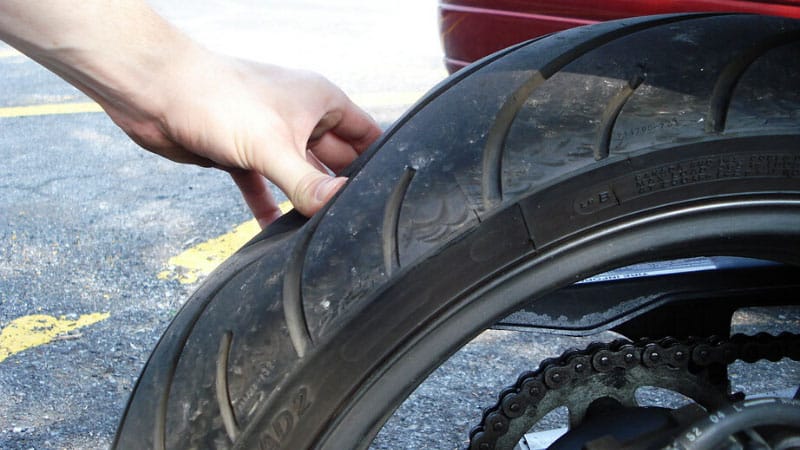 At that point, you can apply a soap-and-water solution to locate damage and any corresponding air leak.
At that point, you can apply a soap-and-water solution to locate damage and any corresponding air leak.
“We always recommend tire technicians use approved tire repair units following recommended industry procedures, in accord with RMA guidelines,” says Brian Buckham, general manager, product marketing, Goodyear. “The technology for repairing truck and bus tires is proven and has remained relatively unchanged for many years. These guidelines can help your technicians repair tires safely and effectively. If done correctly, a repair can last the remaining life of the tire.”
The basic technologies used in tire repair have been around for some time, notes Phil Arnold, field engineer, customer engineering support, Michelin Americas Truck Tires. “However, what has changed is an emphasis on proper training of shop technicians who perform the tire repairs.”
There are many industry guidelines available to help your technicians follow proper repair procedures. Arnold cites the Tire Rubber and Tire Repair Manufacturers Group, the American Trucking Associations’ Technology & Maintenance Council, and the Tire Industry Association, which all publish industry-recommended practices and methods for established tire repair methods as well as new reinforced shoulder repair processes.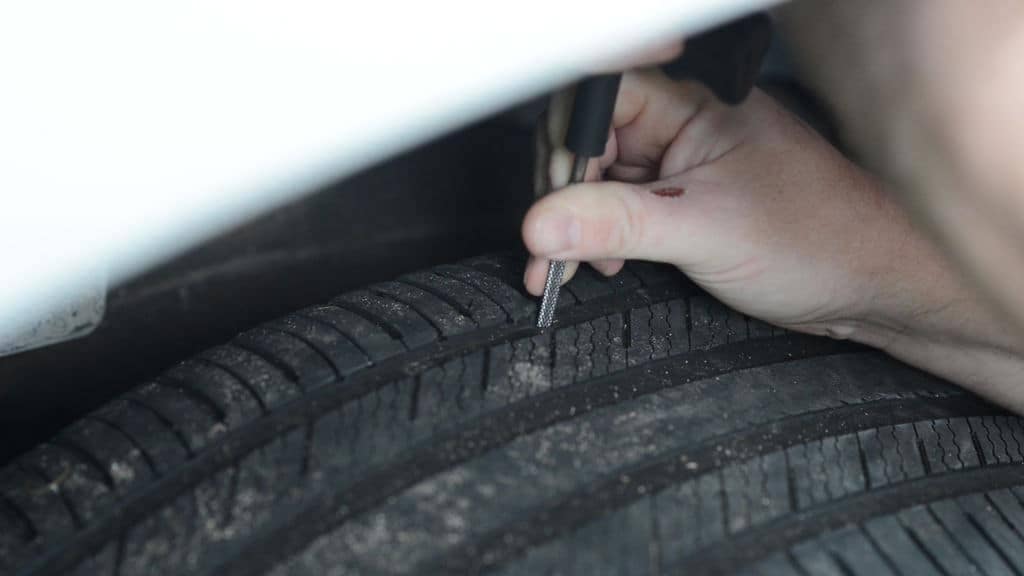
Tire repairs aren’t time consuming, if you have the right tools ready to go. Remember, however, to never mix-and-match glues and patches made by different suppliers.
Once you have located an injury to a tire casing and a pressure leak, it’s time to go to work.
Tubeless passenger car tires today can be quickly repaired using rubber string “plugs.” But plugs aren’t robust enough for commercial vehicle repairs, which instead require both patching the inner casing and filling in the void created when the tire was punctured.
Robert Palmer, director of market sales engineering for Bridgestone Firestone, says technicians should begin by removing the penetrating object from the casing and then temporarily filling the disrupted area with a cured plug or filling material, capped off with curing repair gum. This will keep moisture out of the puncture, which can degrade both the tire casing and the puncture repair.
“Plugging a tire is a temporary measure to retain inflation pressure,” Palmer says. “A permanent repair is always required to ensure you get the full life out of the casing. Filling the injury with string plugs (plugging) is not considered a proper repair. Plugging does not restore the casing integrity and will lead to further degradation of the injury and casing over time. Filling and installing a repair unit is intended to last the life of the casing and restores the casing to be utilized in its original intended application.”
“A permanent repair is always required to ensure you get the full life out of the casing. Filling the injury with string plugs (plugging) is not considered a proper repair. Plugging does not restore the casing integrity and will lead to further degradation of the injury and casing over time. Filling and installing a repair unit is intended to last the life of the casing and restores the casing to be utilized in its original intended application.”
At this point you’re ready to apply a patch to the inner casing of the tire. Using a spreader, open the tire up so you can access the damaged area in the inner casing. Use a clean rag to wipe the puncture area down and remove any damaged tire sections or foreign objects. Use a wire brush or low-speed drill with cutter head to buff the inner casing area around the puncture. You want a “velvet” finish on the tire to give the patch and the cement a tactile surface to adhere to. Be sure to remove any rubber dust from the buffing process from the casing — but do not use compressed air to do so, as it often contains oil and other contaminants that can degrade repair patch integrity.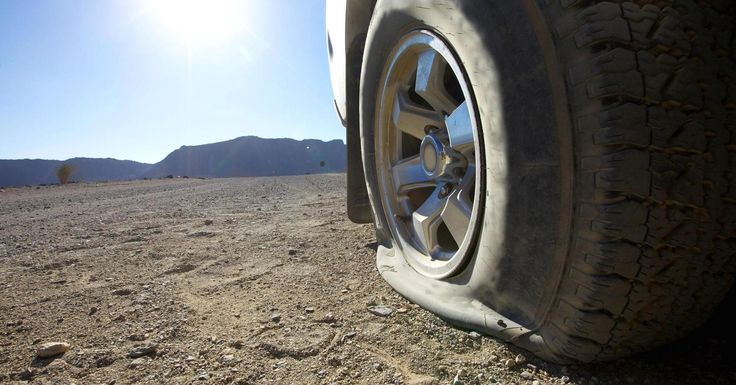
Flat tires never seem to occur in convenient locations. Luckily, many tire manufacturers today have quick-response, roadside assistance programs to help your truck get moving again.
Photo: Goodyear
At this point, the RMA cautions technicians to not mix-and-match patches and glues from different suppliers. Repairs are more effective and last longer if proprietary products are used throughout the repair process. With that in mind, select the appropriate size repair patch required to covered the damaged/prepped area inside the casing. Next, apply rubber cement to the buffed casing surface, then lay the patch down on down on top. Now buff the patch to ensure a good bond with the rubber cement and casing surface.
Arnold stresses that failure to take both steps — plugging the hole and patching the inner casing — can lead to issues with the tire down the road. “An inner liner which is not patched can result in a loss of inflation pressure, and an injury not filled may lead to moisture contamination of the casing, risking loss of tire endurance later,” he says.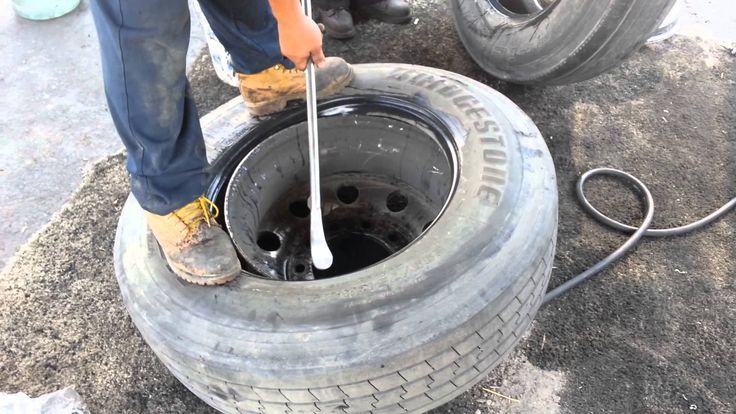
At this point you can reassemble the tire and rim. Next, inflate the tire in a safety cage to recommended pressure and check for leaks with soapy water. If no bubbles appear, the tire is ready to go back into service.
Fleets rely on a wide variety of tire types to get work done. And in most cases, tire repair procedures vary little from type to type. Palmer, for example, notes that wide-base singles and low-rolling-resistance tires are repaired in the same manner as conventional truck tires. “Some tire technicians say that wide single tires are actually easier to repair, as the increased width between the sidewalls and wider tread area make it easier to get inside the tire to perform the repair,” he says.
Punctured tires will remain a fact of life for fleets as long as there are rubber tires and debris in the road. And although repair methods have not changed much over the decades, good training and attention to procedures can usually return damaged tires to full service at a fraction of the cost of a new tire.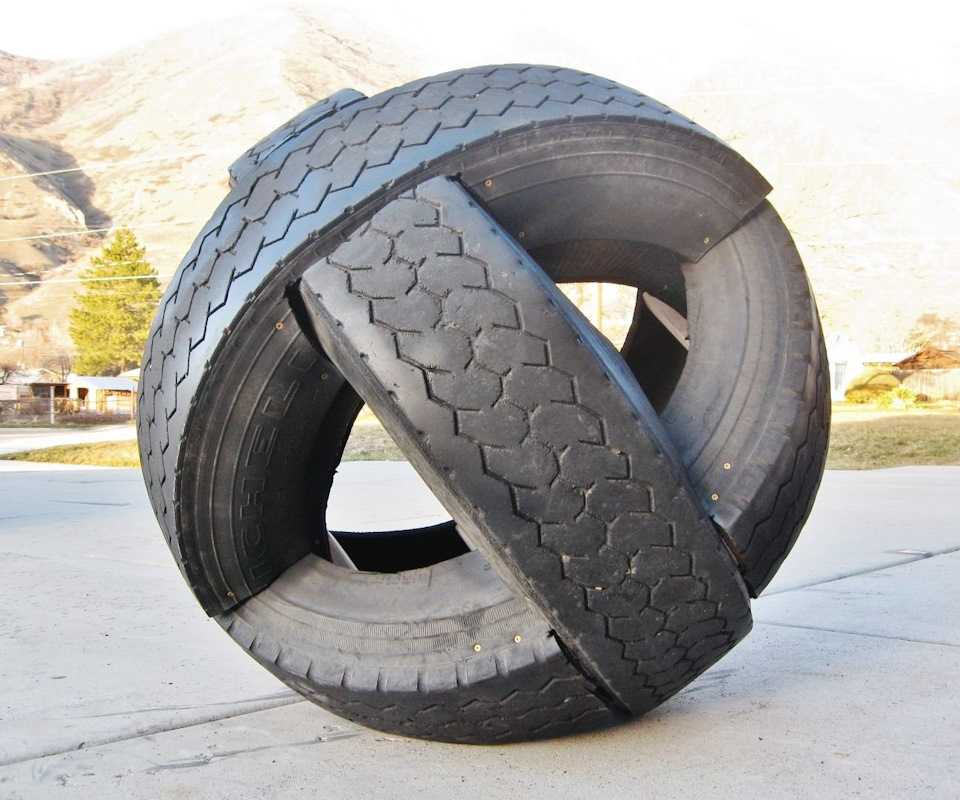
Steer tire is the most critical tires among all tires in a semi truck. It’s located in the front axle, and it handles the overall ride.
It constantly works against 8, 16, 20, or more tires that may go in other directions. They are required to be stiff and rigid, so the truck is maintained in a straight path.
Typically, when a tire loses air, gets punctured, or flat, a tire needs to be patched. But can you do this with a steer tire? Read on to know more.
According to federal regulations, a semi truck’s steer tire can be patched. Repair methods also include recap and plugging of tires. As long as the ruptured area is located on the crown area and the patches don’t overlap with one another, it’s perfectly fine to patch a steer tire.
Table of Contents
To patch a tire is to repair round holes in the tire. It involves applying a patch and a sealant to the affected area, such as a leak or puncture.
It involves applying a patch and a sealant to the affected area, such as a leak or puncture.
A patch is a go-to remedy when the tire hole is only a half or 3/4 inch in diameter.
Patching a tire may require a rubber with adhesive placed in the back and attached to the inside of a damaged tire.
It works better than a plug but is more challenging to do alone, so a professional mechanic is advised.
No law makes patched steer tires illegal. As we know, when the law doesn’t provide, it is deemed legal.
While the federal law provides that a steer tire with “boot, blowout patch, or other ply repairs” cannot pass inspection, the provision is interpreted as section repair.
A section repair is needed when the damage on the tire is so severe. It involves the face, shoulder, and sidewall reinforcement.
So when a steer tire gets punctured or when you run over a nail, you can patch the tire as it’s not prohibited by law.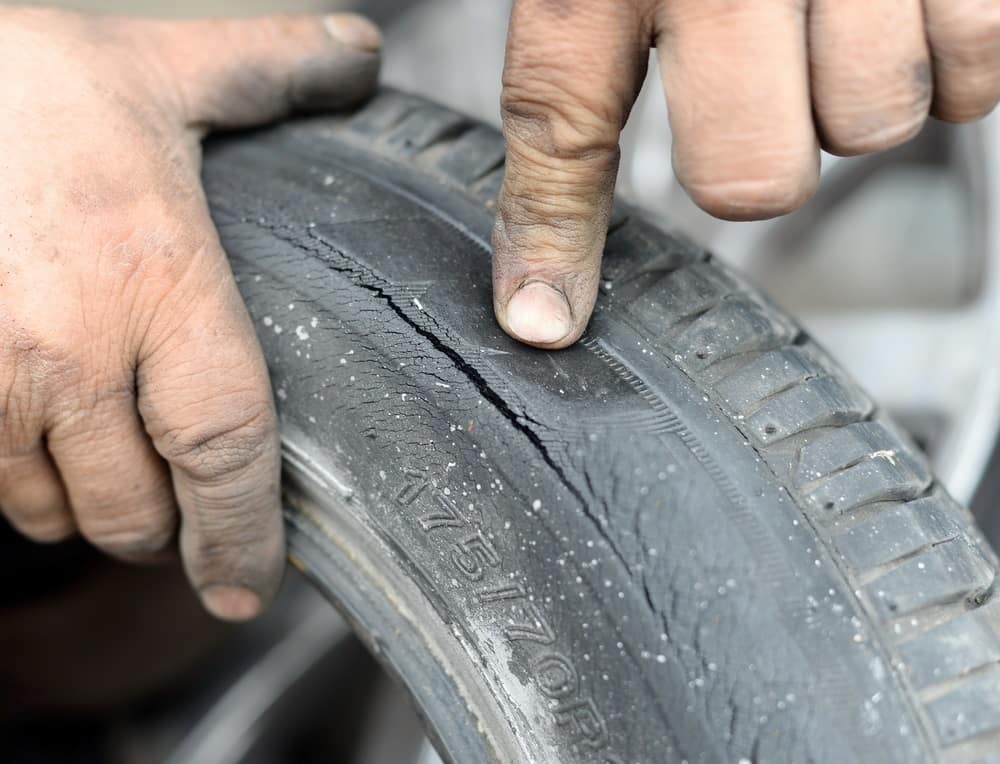
You can plug a steer tire on a semi truck as there’s no existing law barring it.
However, this route should only be done when there’s no other choice, like you’re in the middle of the road and have no spare tire.
Steer tire plugs are not replacements for a proper punctured tire. This option can be the quick remedy for a damaged tire, but it can fail and may cause severe damage to the tire over time.
Recap tires are a common practice in the fleet industry. It is usually known as a retread tire.
In this method, the tire undergoes a remanufacturing procedure where the worn tread on a tire is replaced with new ones to prolong the tire’s life.
Retread or recap can be done in steer tires in a semi truck. However, this practice is banned on commercial buses by the FMCSA.
Many truck operators recap their steer tire once and the drive tires at least twice before moving the tires to the trailer position.
If you decide to recap your tires, make sure to work with professional retreaders. They inspect the damage thoroughly, and it will give you peace of mind knowing that the tire is professionally fixed.
Steer tires can endure several patches. Steer tires are designed to be durable and tough, so you can patch any type of steer tires of a semi truck.
However, patches and any type of repairs are only limited to the thread area. It’s also not recommended to patch a 1-inch hole in the tire.
You can’t just patch anywhere in the steer tire. Patch on the steer tire should be done in the crown area or center thread.
In the crown area, there’s no limit to the number of holes to be patched. But if punctures are located in the sidewall or shoulder of the tires, there’s no way you can repair it by patching the tire.
Again, patching a steer tire involves fixing a puncture or flat tire.
You can do the process yourself if the damage is not severe; otherwise, you may need professional help from a mechanic.
Here are the simple steps to properly patch the steer tire;
Step 1. Find the damage
The first step to patching a tire is to find the rupture. If the hole is so tiny, you can soak the tire in a tank filled with water so you will see the escaping water.
Other use soapy water as bubbles quickly come out from the tire.
Step 2. Prepare the tire with a buffing tool or scraper
The ruptured area is prepared through the buffing tool and scraper. In this procedure, you need a cleaning solution to help the tire bond and make it suitable for the repair patch.
Step 3. Apply a vulcanizing cement
To ensure that no water will enter inside the tire, apply a vulcanizing cement on the buffed area. Wait until the adhesive is safe to touch.
Step 4. Put the patch inside and pull it to the hole
Remove the plastic side of the hole first and make sure that the sticky side will go inside the tire.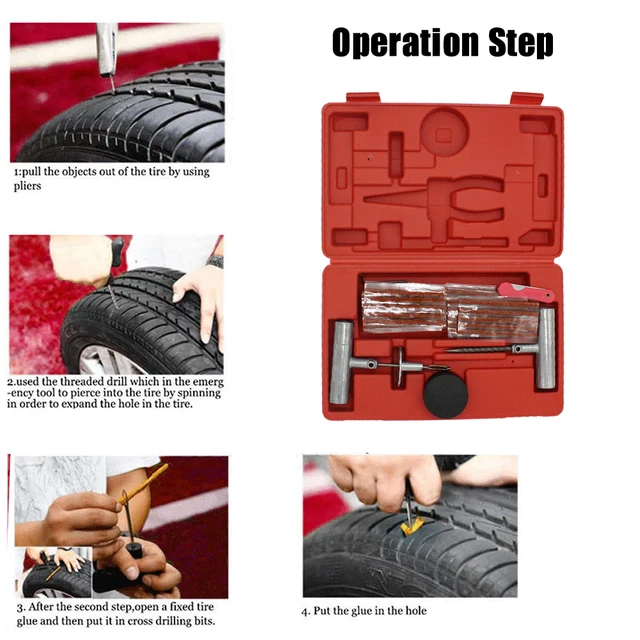 When the patch is already inside the tire, you must push it outside through the hole.
When the patch is already inside the tire, you must push it outside through the hole.
You will need a pair of pliers to push the pointy side of the patch outside so the sticky side is pulled to the hole tightly.
Step 5. Apply a sealant
Apply a sealant all over the patch and other tire parts that may be prone to air bubbles. The sealant will ensure that there will be no leaks.
Step 6. Cut the pointy side or stem of the patch
When the sealant is dry, you can now cut the pointy part of the patch with a cutter or scissors. After doing so, you can put the tire back on the rim.
A proper patched tire will serve you longer. However, take note that the rupture must be located in the crown area of the tire.
If it’s on the shoulder, adjacent area, or sidewall, the damage cannot be fixed by patching the tire.
A patched tire can last for a long time than a plugged steer tire. On average, you can drive a properly patched tire for another seven years.
On average, you can drive a properly patched tire for another seven years.
In most cases, it can even outlive the life of the semi truck’s original tire. However, experts recommend changing tires every after six years in the life of a truck.
Moreover, its life can be extended more if the truck is not driven in extreme conditions and a professional mechanic does the patch.
Although the life of patched steer tires can be extended for a while, it is not advisable to patch it over and over again. If you do so, it will cause blowouts, or the truck’s speed will be affected.
If you have only patched the steer tire once, you can still drive the same speed as the original tire on a smooth road. While you can still move at the same speed off-road, you have to be a bit cautious.
In addition, if the steer tire patch is appropriately done, you will feel as if no repairs have been done.
To be sure, you can safely drive 90 miles per hour with a steer tire. If you want to go faster than that, it’s best and safe to get a new steer tire.
All tires are built with steer tires in mind. The steer tire casing is mostly similar to drive and trailer tires. They only vary in the compounding and thread designs.
So, in general, you can swap a steer tire with drive axle tires so long as the material and the sizes are matched.
In fact, all tires can be positioned in various positions to extend their lives. For instance, new tires are placed in front or steer axle, and older tires are set in the trailer.
However, the swapping should only be your last resort. Nothing beats a steer tire or drive tires positioned in their recommended positions.
After all, steer tires are built to perform at their best. They are responsible for handling the vehicle, and they ensure that it maintains the straight direction while other tires tend to move otherwise.
The drive axle is responsible for the traction to ensure that the vehicle will keep moving.
Since steer and drive axles have different jobs, they may be made with various designs. In some instances, a steer tire features a ribbed design, while drive tires have a lug-type thread design.
If this is the case, you can still swap the tires, but it may not be a good idea to do so. If the original steer tire is a rib-design, it is best to replace it with a rib-design tire.
The DOT laws limit the unsold tire for only six years. No tires older than six years shall be sold on installed in a semi truck.
Further, the federal government imposed a minimum thread depth of 4/32 inches for steer tires. A manufacturer will be issued a citation if he sells a tire with lesser thread depth than recommended.
This is to ensure that the steer tire is tough and will not wear quickly.
The only law that regulates steer tire repairs is the Federal Motor Carrier Safety Regulations (FMSCR).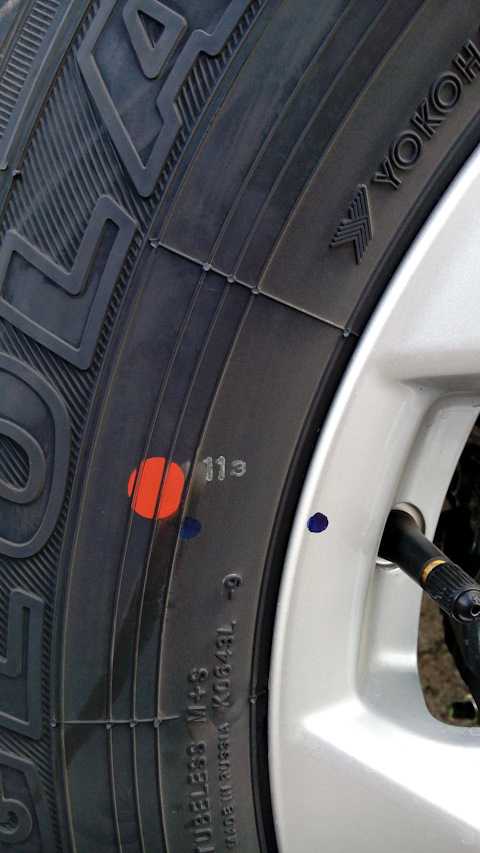 When it comes to patching a steer tire, no law prohibits doing so.
When it comes to patching a steer tire, no law prohibits doing so.
Nothing in the law that says patching a tire is illegal. Even the number of holes or punctures that need repairs are not mentioned.
Therefore, you can fix a tire for an unlimited time so long as the repairs don’t overlap and the damage is on the center tire.
The law was written more than 60 years ago, and it’s a bit vague. But according to experts, what is prohibited is using a steer tire that has undergone section repairs.
Keep in mind that what the law excludes is legal. So if the recap or plug tires is also a question in mind, take note that it’s also legal because no law is barring the same.
The service collects information from 8 countries: the Republic of Belarus, the Russian Federation, Ukraine, Kazakhstan, Moldova, Kyrgyzstan, Uzbekistan, Armenia
Real-time search for information about a specific company time.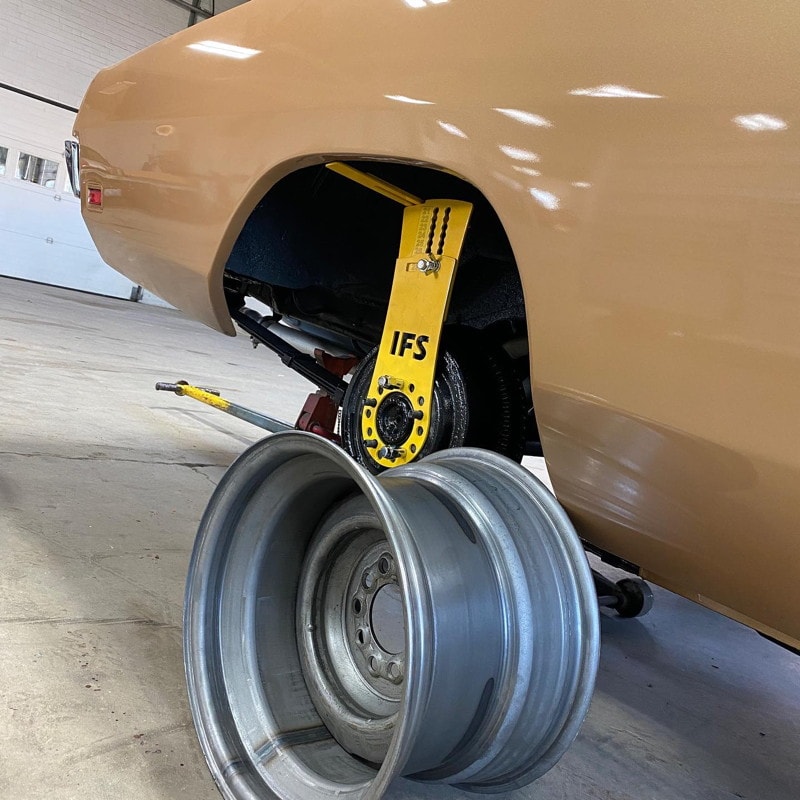
All information on the resource is accumulated from official sources.
Search for counterparties is carried out according to the main registration data.
Business relationships between companies are always associated with various kinds of risks, which are determined by the stability, competence and financial position of the partners. Partners often act as partners, with whom companies enter into contracts for the supply of certain products. In order for the transaction to be completely legal and not bring a lot of problems with regulatory authorities, it is important to check the counterparty against various databases before concluding an agreement using specialized sources. Having complete information about the real situation of the counterparty, you can protect yourself from fictitious business transactions and get a complete picture of the counterparty, assessing its solvency and the legitimacy of doing business. Up-to-date information about the partner is the key to making profitable deals.
Up-to-date information about the partner is the key to making profitable deals.
Search for organizations registered in the unified state register of the Republic of Belarus. The list of data provided for Belarusian companies includes: registration data (address of the subject, name, registration dates, status), type of activity, information about trade facilities (location of the trade facility, classes of goods, registration number)
Search entities registered with the Federal Tax Service of Russia. The list of data provided for companies in the Russian Federation includes: registration data (address of the subject, name, registration dates, status), type of activity, information about managers, information about the authorized capital, data on the average headcount, company revenue, enforcement proceedings, quantitative data on arbitration
Organizations registered with the Ministry of Justice of Ukraine.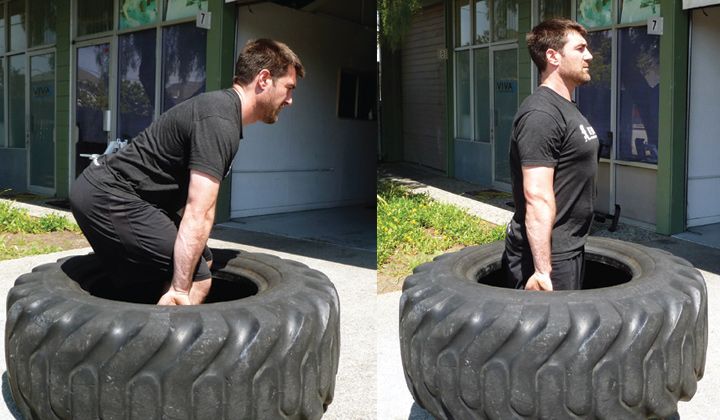 The list of data provided for Ukrainian companies includes: registration data (subject address, name, registration dates, status), type of activity, information on authorized capital
The list of data provided for Ukrainian companies includes: registration data (subject address, name, registration dates, status), type of activity, information on authorized capital
Search for organizations registered in Kazakhstan. The list of data provided for companies in Kazakhstan includes: registration data (address of the subject, name, registration dates), type of activity, information about the head
Search for companies registered in Uzbekistan. The list of data provided for companies in Uzbekistan includes: registration data (address of the subject, name, registration dates), type of activity, information about the head
Organizations registered in Moldova. The list of data provided for Moldovan companies includes: registration data (address of the subject, name, registration dates), types of activities, information about the head
Companies registered in Kyrgyzstan.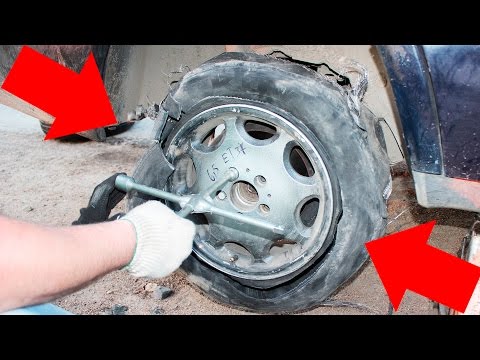 The list of data provided for companies in Kyrgyzstan includes: registration data (address of the subject, name, registration dates), type of activity, information about the head
The list of data provided for companies in Kyrgyzstan includes: registration data (address of the subject, name, registration dates), type of activity, information about the head
Companies registered in Armenia. The list of data provided for companies in Armenia includes: registration data (address of the subject, name, registration dates)
Having complete information about the real situation of the counterparty, you can protect yourself from fictitious business transactions and get a complete picture of the counterparty, assessing its solvency and the legitimacy of doing business. Up-to-date information about the partner is the key to making profitable deals.
All news0005
We use cookies to improve the site. By staying on our site, you agree With conditions use of cookies.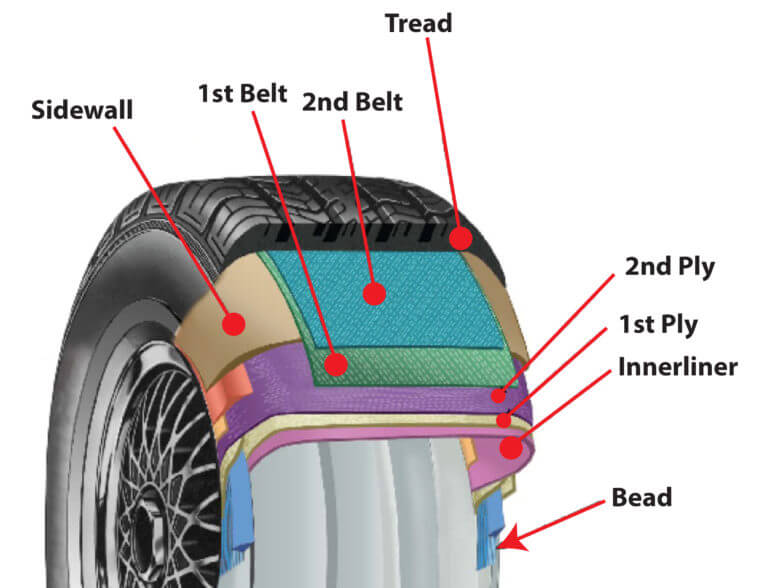 To read our Privacy Statement and use cookies, click here.
To read our Privacy Statement and use cookies, click here.
Artem Polushin, Deputy Head of the Strategic Development Department of the CPPK, goes to work / Photo: Moskovsky transport
Today is World Car Free Day. This annual action was supported by many residents of the capital, including the heads of city institutions.
On Wednesday Yulia Temnikova, Deputy Head of the Moscow Metro, decided to give up her personal car in favor of traveling by public transport. She has been participating in this action for more than a year.
“This time I decided to take the tram to work,” she shared. — I got from my house to the Ploshchad Tverskaya Zastava stop by metro, and then chose a convenient tram route that goes straight to my office on Prospekt Mira.
Yulia Temnikova / Photo: Moskovsky transport
According to Temnikova, she chose this mode of transport because of its mobility and modernity.
— For example, in a tram you can charge your phone during the trip, — she said. - In general, I often use public transport to see for myself the quality of our work for passengers.
Roman Latypov / Photo: Moskovsky transport
Roman Latypov, First Deputy Head of the Department of Transport and Road Infrastructure Development, also decided to switch to public transport that day. He chose the Moscow Central Circle, one of the stops of which is right at Moscow City, next to his office.
— A day without a car is not uncommon for me, so I joined this action with pleasure. I often use public transport to get to work in the morning or move between meetings during the day,” he said. - By car, my way to work takes 1.5 hours, and by train with a transition to the MCC - only 40 minutes. It is convenient, safe and predictable in time.
Alena Eremina / Photo: Moskovsky transport
Alena Eremina, press secretary of Moscow transport, also chooses public transport.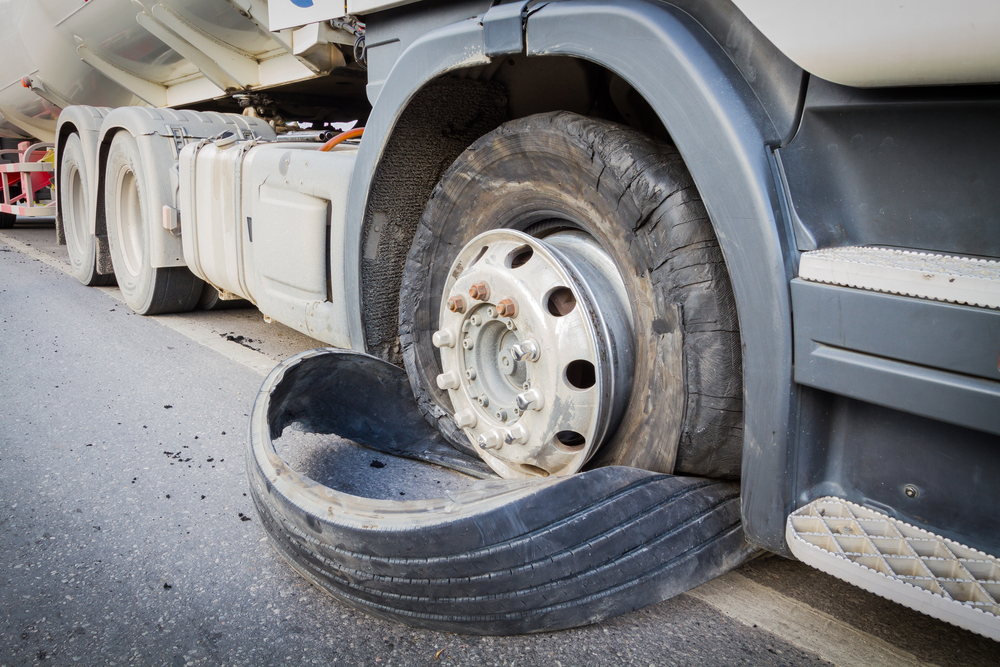 She reminded all residents of the capital that harmful emissions from cars are one of the main threats to humans and the planet.
She reminded all residents of the capital that harmful emissions from cars are one of the main threats to humans and the planet.
— Let's choose city transport more often and make our cities cleaner and safer! — said Alena Eremina.
Dmitry Gorshkov / Photo: Moskovskij transport
Dmitry Gorshkov, Deputy Head of the Traffic Management Center, joined the action.
“Giving up a car even for one day is a big contribution to the ecology of the city and the health of your loved ones,” he says. — I chose the train, bus and scooter. By the way, the route was built in the Moscow Transport application. It also allows you to choose the most environmentally friendly travel option.
Artem Burlakov / Photo: Moskovsky transport
And some executives go to work by public transport on a regular basis. For example, Artem Burlakov, Deputy Head of the Energy and Innovation Projects Service of Mosgortrans, has been choosing an electric bus for three years.
— For me, this is the main, reliable and comfortable mode of transport, — he said.
Ilya Pyrsin / Photo: Moskovsky Transport
Ilya Pyrsin, First Deputy Head of the Moscow Administrative Road Inspectorate, also cares about the environment.
— I take the metro to Elektrozavodskaya, and then change to an electric bus, which literally takes me to the inspection in seven minutes. The presence of Wi-Fi and charging allows you to immerse yourself in work and competently plan your day,” he shared.
Vladislav Sultanov, the head of the State Institution "Organizer of Transportation", also drove to work on an electric bus. He uses it constantly, and once again saved travel time.
Alexey Mityaev / Photo: Moskovsky transport
Other employees of the transport complex also supported the action. Aleksey Mityaev, adviser to the head of the Department of Transport, believes that in Moscow one can live without a car.
— I've been without personal transport for 3 years - I use scooters, buses and carsharing, — he said.
Andrey Koshelev / Photo: Moskovsky transport
Andrey Koshelev, Deputy Head of the Moscow Metro for Development, said World Car Free Day reminds him of two important things.
— The first is our goal to develop transport in such a way that owners of personal cars become our regular passengers. Together with colleagues, we often travel by public transport, because it is faster. And secondly, by using public transport, we make a great contribution to the conservation of nature. We think about the environment, resources and the state of the air that we and our children breathe,” he said.
Aleksey Fomichev / Photo: Moskovsky transport
Aleksey Fomichev, Deputy General Director of SUE Mosgortrans, noted that our buses and electric buses are equipped with everything necessary for safe and fast travel.
— We, as the main operator of urban surface transport in Moscow, call on residents and guests of the capital to contribute to improving the city's ecology, — he stressed.
Photo: Moskovsky transport
AMPP First Deputy General Director Natalia Salnikova said that she regularly comes to work by public transport.
- But I especially recommend the electric bus - it's always clean, rides smoothly and quietly. Absolutely my favorite mode of transport, she shared.
Artem Polushin / Photo: Moskovsky Transport
Artem Polushin, Deputy Head of the Strategic Development Department of the CPPK, said that his daily commute to work starts from the railway station.
- I will wait no more than 6 minutes for the train, and it will take me to the center of Moscow. In general, trips in transport help a lot in work, when you see the whole process with your own eyes, more ideas arise for the development of railways,” he said.
Andrey Filatov / Photo: Moskovsky transport
Andrey Filatov, First Deputy Director General of the MT PPK, travels to the office every day by subway, despite being able to use official transport.
— So I am 100 percent sure that I will arrive on time and not lose time in traffic. In addition, only constant trips by public transport can suggest what passengers need and in what aspects it needs to be developed. Therefore, I unconditionally support the “Day without a car” campaign – for someone it will definitely open up new, more convenient and environmentally friendly travel options,” he said.
Alina Bisembayeva / Photo: Moskovsky transport
Aeroexpress General Director Alina Bisembayeva prefers electric transport.
— For work, I often visit Sheremetyevo, Domodedovo and Vnukovo. On a business trip to the airport, as well as on a passenger's trip to the airport with an air ticket in hand, the most important thing is time, which is why I always travel by Aeroexpress. This is the only way I can be sure that I will be in time for all the scheduled meetings. On business in the city center I often take the metro or the MCC. All these modes of transport are not only fast and convenient, but, importantly, environmentally friendly,” she shared.
This is the only way I can be sure that I will be in time for all the scheduled meetings. On business in the city center I often take the metro or the MCC. All these modes of transport are not only fast and convenient, but, importantly, environmentally friendly,” she shared.
Mikhail Grafchikov / Photo: Moskovskij transport
Deputy General Director, Commercial Director of Aeroexpress Mikhail Grafchikov has a similar opinion.
— Our office is located at Sheremetyevo Airport, and every day I get to work first by metro and then by Aeroexpress, not only on World Car Free Day. Often, to get to the metro, I also use a bike rental. On the way, I spend time usefully: in the metro I have time to read the news on my smartphone, in the Aeroexpress train I switch to a laptop and already fully start my working day, because both the metro and the train have Wi-Fi,” he said.
Vladimir Titov / Photo: Moskovsky Transport
Director of MosTransProject Research Institute Vladimir Titov believes that the Day Without a Car is not just a flash mob, but an important way to remind us that cities without cars are healthy, comfortable and spacious cities without noise and pollution.